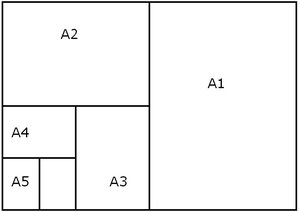ISO 216
|
|
| A Series | |
|---|---|
| A0 | 841×1189 |
| A1 | 594×841 |
| A2 | 420×594 |
| A3 | 297×420 |
| A4 | 210×297 |
| A5 | 148×210 |
| A6 | 105×148 |
| A7 | 74×105 |
| A8 | 52×74 |
| A9 | 37×52 |
| A10 | 26×37 |
| B Series | |
| B0 | 1000×1414 |
| B1 | 707×1000 |
| B2 | 500×707 |
| B3 | 353×500 |
| B4 | 250×353 |
| B5 | 176×250 |
| B6 | 125×176 |
| B7 | 88×125 |
| B8 | 62×88 |
| B9 | 44×62 |
| B10 | 31×44 |
| C Series | |
| C0 | 917×1297 |
| C1 | 648×917 |
| C2 | 458×648 |
| C3 | 324×458 |
| C4 | 229×324 |
| C5 | 162×229 |
| C6 | 114×162 |
| C7 | 81×114 |
| C8 | 57×81 |
| C9 | 40×57 |
| C10 | 28×40 |
| DL | 110×220 |
| C7/6 | 81×162 |
ISO 216 specifies international standard (ISO) paper sizes, used in most countries in the world today. It is the standard which defines the well-known A4 paper size.
The standard was originally adopted by DIN (as DIN 476) in Germany in 1922, although some of the formats contained therein were independently invented in France during its revolution and later forgotten.
ISO 216 defines three series of paper sizes: A, B and C. Series C is primarily used for envelopes.
Paper in the A series format has a 1:√2 aspect ratio, although this is rounded to the nearest millimetre. A0 is defined so that it has an area of 1 m², prior to the above mentioned rounding. Successive paper sizes in the series A1, A2, A3, etc., are defined by halving the preceding paper size parallel to its shorter side, again prior to rounding. The most frequently used paper size is A4, which is 210 × 297 mm.
The B series formats are geometric means between the A series format with the same number and the A series format with one higher number. For example, B1 is a geometric mean between A1 and A0. Likewise, the C series formats are geometric means between the B series format with the same number and the A series format with the same number, e.g. C2 is the geometric mean between B2 and A2. There is also an incompatible Japanese B series defined by the JIS. The lengths of JIS B series paper are approximately 1.22 times those of A-series paper.
The C series formats are used mainly for envelopes. An A4 page will fit into a C4 envelope. If you fold the A4 page so that is A5 in size, it will fit in a C5 envelope and so on.
Prior to the adoption of ISO 216, many different paper formats were used internationally. These formats did not fit into a coherent system and were defined in terms of non-metric units. The ISO 216 formats are organized around the ratio 1:√2; two sheets next to each other together have the same ratio, sideways. This simplifies copying two A4 sheets in reduced size on one, and copying an A4 sheet in magnified size on an A3 sheet or copying half an A4 sheet in magnified size on an A4 sheet. The principal countries not generally using the ISO paper sizes are the United States of America and Canada, which use the Letter, Legal, and Executive system. (Canada uses a P-series of sizes, which are the American paper sizes rounded to metric dimensions).
External links
- Details (http://www.cl.cam.ac.uk/~mgk25/iso-paper.html) about paper sizesde:ISO 216

